Renewable Energy and Decarbonization in the Canadian Mining Industry: Opportunities and Challenges
Abstract
:1. Introduction
2. Research Methodology
3. Current Active Projects Related to Renewable Energy Development in Canadian Mining
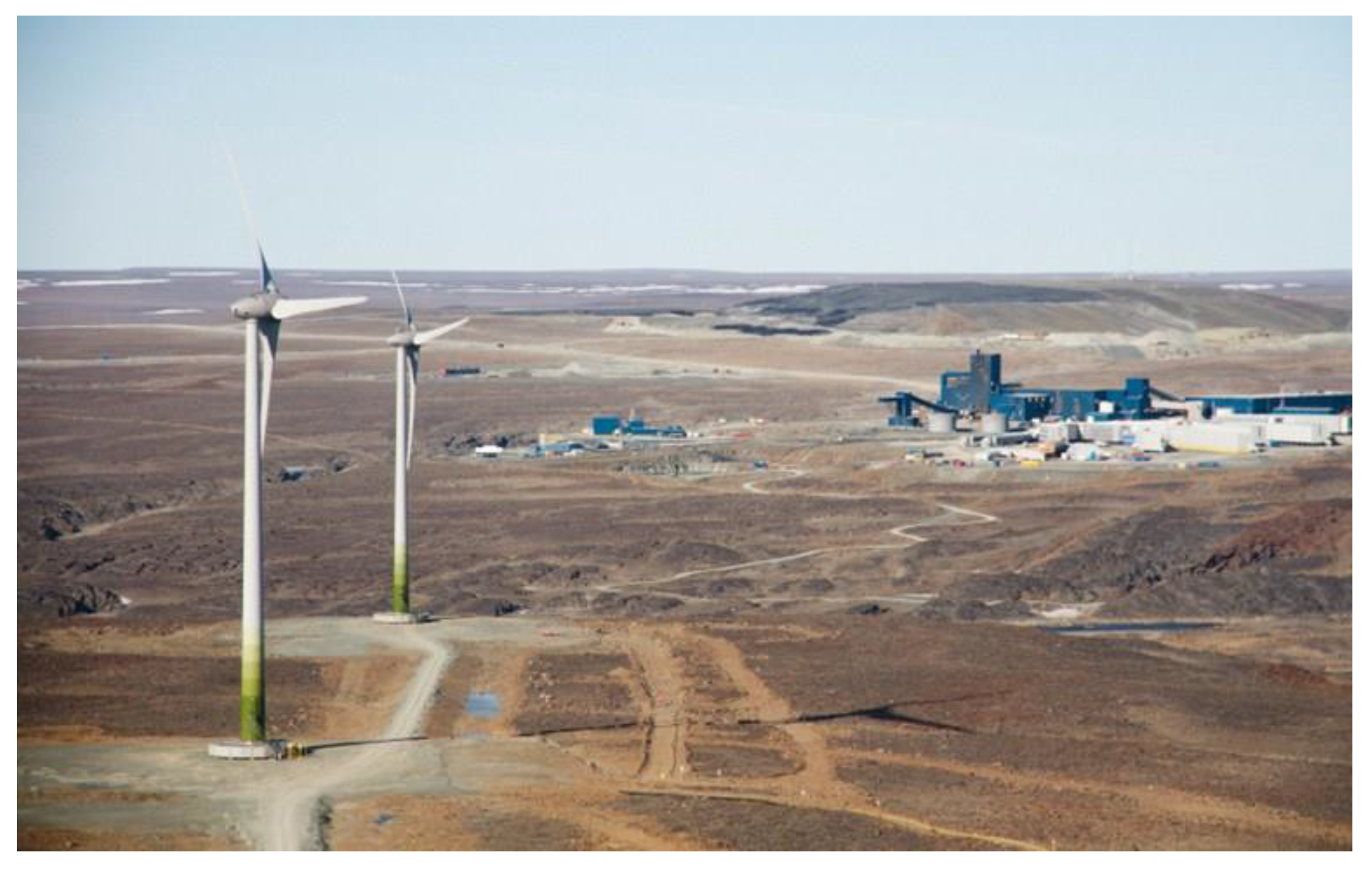
- PV System at Raglan Mine (Quebec): Commencing in July 2021, this study evaluates the efficacy of solar energy production in Canada’s northern regions. The installation, located near the wind turbines at Mine 2, incorporates 108 bifacial panels, generating 40 kilowatt-peak (kWp) energy [30]. This project is still considered a pilot project in the northern region of Quebec.
- PV System at SunMine (British Columbia): Initiated in 2014, SunMine is a groundbreaking 2 MW solar field connected to the British Columbia grid. Remarkably, it is the first solar farm on a reclaimed abandoned mine site. Teck Resources invested CAD 70 million over five years to reclaim the site following the mine closure. The site continues to manage drainage water, as shown in Figure 3 [31,32].
- PV System at Snowline Gold’s Forks Camp (Canada): An off-grid system at this remote gold mine encampment encompasses a lithium-ion battery bank, a power rack for equipment organization, and 64 bifacial modules on a ground mount (all rated at 27 kW). This configuration is expected to reduce carbon emissions by 90% and save an estimated 12,527 L of fuel annually by providing power to the 45-person exploration camp and recharging the battery bank [33].
4. Opportunities for Integrating RE into Off-Grid Mining Operations
4.1. Meeting Electricity and Heating through RE
4.2. Replacing Diesel with RE for Transportation
4.3. Making Hydrogen with RE
4.4. Electrifying Communities Nearby
5. Electrification Alternatives in Canadian Mines
5.1. Installation of a Trolley-Assist System for Diesel-Electric Trucks
- Increasing Carbon Taxes: Adopting trolley assist can substantially mitigate Copper Mountain’s carbon tax liabilities as these taxes continue to rise.
- Escalating Diesel Costs: Using the trolley-assist system, each hybrid Komatsu haul truck consumes 400 L of diesel (equivalent to 1 ton of CO2) per hour. Additionally, transitioning to clean power sourced from BC Hydro offers a more predictable cost structure than diesel’s unpredictable availability and pricing fluctuations.
- Enhanced Efficiency: Deploying hybrid trucks equipped with trolley assist translates to more efficient mineral transportation within shorter time frames.
- Reduced Environmental Impact: With the support of the BC Government, Copper Mountain is aligning with efforts to bestow “responsible metals” credentials on their products as they traverse the supply chain. This designation positions these items for premium trading, ultimately augmenting their value.
5.2. Integration of In-Pit Crushing and Conveying Systems
- Energy Savings: Conveying minerals through conveyors inherently demands less energy per unit weight than transporting them via trucks [78]. Notably, only 39% of the energy utilized in a truck cycle is dedicated to moving the payload, with the remaining 61% allocated to moving the vehicle’s weight. Additionally, by relying on electricity-based methods, IPCC systems can reduce a mine’s reliance on diesel fuel.
- Environmental Impact (Dust and Noise): Implementing IPCC systems can reduce noise pollution as conveyors generate less noise than conventional diesel-powered trucks. Moreover, reducing the number of trucks on the road can significantly diminish the dust emissions sources, positively impacting the environment [78].
- CO2 Emissions: IPCC systems can substantially reduce CO2 emissions by facilitating fuel switching. A noteworthy example is found in a Brazilian iron ore mine that has integrated two fully mobile IPCC systems, collectively capable of handling 7800 t/h, resulting in an estimated reduction of 60 million liters of diesel consumption annually [79]. This approach aligns with utilizing renewable energy sources, such as hydroelectric, solar, and wind-based electricity, to transform IPCC into a decarbonized transport mining system.
- Operational Costs: As mining activities escalate, waste dumps grow, and the pit becomes deeper. This progression leads to longer truck haul cycles and increased demand for additional trucks to meet production requirements. Truck hauling is frequently perceived as more costly than IPCC methods, particularly with increased distances and elevation [80]. Embracing an IPCC system over a truck haulage system can significantly reduce material transport operating expenses (OPEX), owing to potential savings from energy conservation, workforce reduction, enhanced weight efficiency, and lower maintenance costs.
- Production Efficiency: The continuous transportation approach offered by IPCC systems often translates to increased production rates. This approach involves transporting ore or waste materials to designated locations consistently and efficiently [81]. A comprehensive comparison of the two systems (TS/IPCC) based on time utilization, operational time, and useful operating time metrics underscores the greater production efficiency associated with conveyor haulage when considering overall equipment performance.
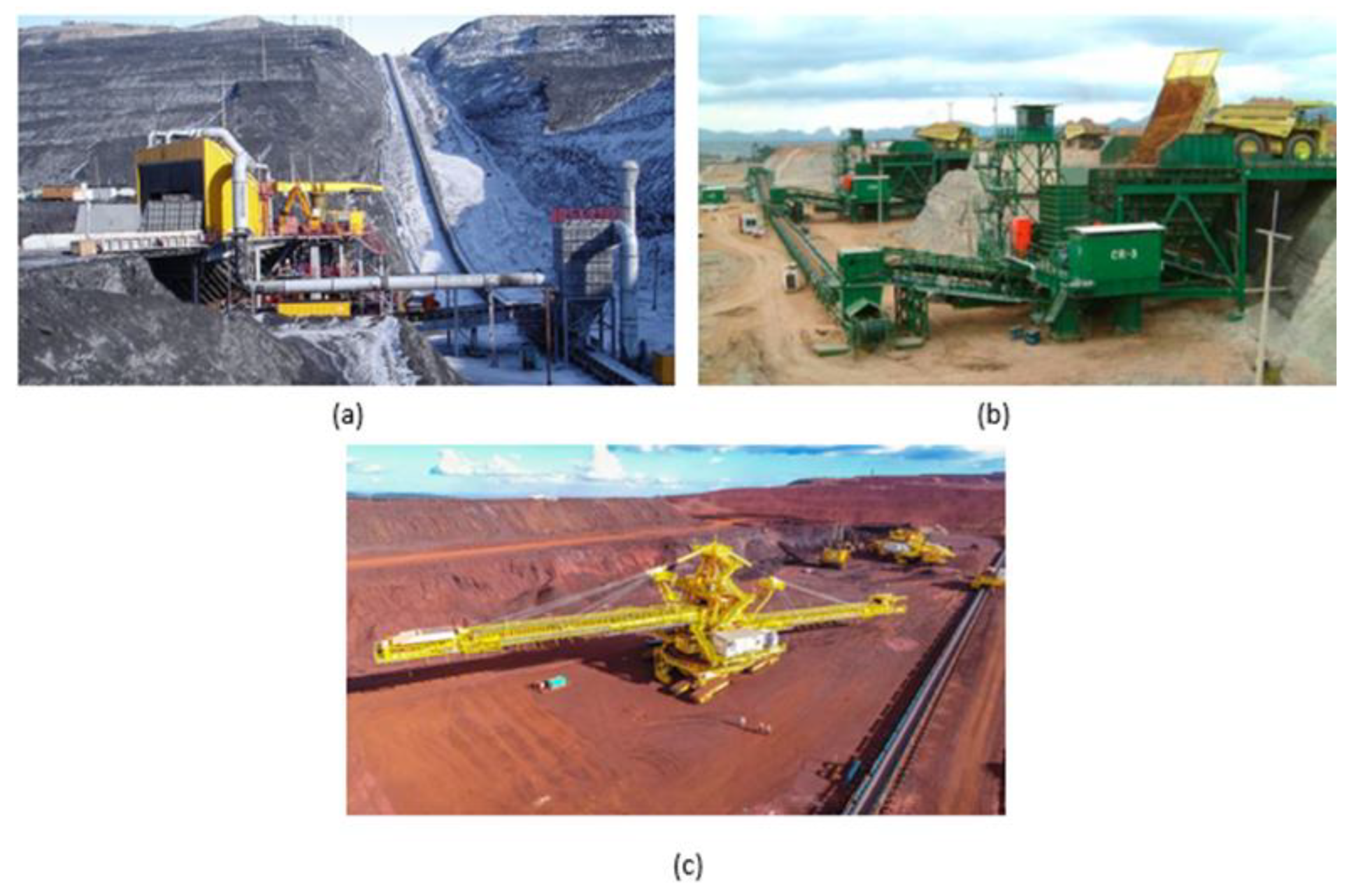
6. Challenges for RE and Transport Electrification in Canadian Mines
6.1. Technical Challenges
6.2. Expertise and Logistics
6.3. Financing
6.4. Research and Development
6.5. Business Models
6.6. Main Challenges of Integrating RE and Electrifying Canadian Mine Sites
7. Conclusions
Author Contributions
Funding
Data Availability Statement
Conflicts of Interest
References
- Gorman, M.R.; Dzombak, D.A. A review of sustainable mining and resource management: Transitioning from the life cycle of the mine to the life cycle of the mineral. Resour. Conserv. Recycl. 2018, 137, 281–291. [Google Scholar] [CrossRef]
- Ranjith, P.G.; Zhao, J.; Ju, M.; De Silva, R.V.; Rathnaweera, T.D.; Bandara, A.K. Opportunities and challenges in deep mining: A brief review. Engineering 2017, 3, 546–551. [Google Scholar] [CrossRef]
- Bharathan, B.; Sasmito, A.P.; Ghoreishi-Madiseh, S.A. Analysis of energy consumption and carbon footprint from underground haulage with different power sources in typical Canadian mines. J. Clean. Prod. 2017, 166, 21–31. [Google Scholar] [CrossRef]
- Davis, M.; Ahiduzzaman, M.; Kumar, A. How will Canada’s greenhouse gas emissions change by 2050? A disaggregated analysis of past and future greenhouse gas emissions using bottom-up energy modelling and Sankey diagrams. Appl. Energy 2018, 220, 754–786. [Google Scholar] [CrossRef]
- Ahoutou, Y.; Ilinca, A.; Issa, M. Electrochemical cells and storage technologies to increase renewable energy share in cold climate conditions—A critical assessment. Energies 2022, 15, 1579. [Google Scholar] [CrossRef]
- Issa, M.; Rezkallah, M.; Ilinca, A.; Ibrahim, H. Grid integrated non-renewable based hybrid systems: Control strategies, optimization, and modeling. In Hybrid Technologies for Power Generation; Academic Press: Cambridge, MA, USA, 2022; pp. 101–135. [Google Scholar]
- Issa, M. Optimisation Opérationnelle, Écologique et Énergétique des Groupes Électrogènes Diesel. Ph.D. Thesis, Université du Québec à Rimouski, Rimouski, QC, Canada, 2020. [Google Scholar]
- Bao, H.; Knights, P.; Kizil, M.; Nehring, M. Electrification Alternatives for Open Pit Mine Haulage. Mining 2023, 3, 1–25. [Google Scholar] [CrossRef]
- Jordaan, S.M.; Romo-Rabago, E.; McLeary, R.; Reidy, L.; Nazari, J.; Herremans, I.M. The role of energy technology innovation in reducing greenhouse gas emissions: A case study of Canada. Renew. Sustain. Energy Rev. 2017, 78, 1397–1409. [Google Scholar] [CrossRef]
- Issa, M.; Ilinca, A.; Martini, F. Ship Energy Efficiency and Maritime Sector Initiatives to Reduce Carbon Emissions. Energies 2022, 15, 7910. [Google Scholar] [CrossRef]
- Leggett, J.A. The United Nations Framework Convention on Climate Change, the Kyoto Protocol, and the Paris Agreement: A Summary; UNFCC: New York, NY, USA, 2020; Volume 2. [Google Scholar]
- Shishlov, I.; Morel, R.; Bellassen, V. Compliance of the Parties to the Kyoto Protocol in the first commitment period. Clim. Policy 2016, 16, 768–782. [Google Scholar] [CrossRef]
- Lau, H.C.; Ramakrishna, S.; Zhang, K.; Radhamani, A.V. The role of carbon capture and storage in the energy transition. Energy Fuels 2021, 35, 7364–7386. [Google Scholar] [CrossRef]
- Cox, B.; Innis, S.; Kunz, N.C.; Steen, J. The mining industry as a net beneficiary of a global tax on carbon emissions. Commun. Earth Environ. 2022, 3, 17. [Google Scholar] [CrossRef]
- Ulrich, S.; Trench, A.; Hagemann, S. Gold mining greenhouse gas emissions, abatement measures, and the impact of a carbon price. J. Clean. Prod. 2022, 340, 130851. [Google Scholar] [CrossRef]
- Zhu, Y.; Ghosh, M.; Luo, D.; Macaluso, N.; Rattray, J. Revenue recycling and cost-effective GHG abatement: An exploratory analysis using a global multi-sector multi-region CGE model. Clim. Change Econ. 2018, 9, 1840009. [Google Scholar] [CrossRef]
- Tost, M.; Bayer, B.; Hitch, M.; Lutter, S.; Moser, P.; Feiel, S. Metal mining’s environmental pressures: A review and updated estimates on CO2 emissions, water use, and land requirements. Sustainability 2018, 10, 2881. [Google Scholar] [CrossRef]
- Nadeau, S.; Badri, A.; Wells, R.; Neumann, P.; Kenny, G.; Morrison, D. Sustainable Canadian mining: Occupational health and safety challenges. In Proceedings of the Human Factors and Ergonomics Society Annual Meeting; SAGE Publications: Los Angeles, CA, USA, 2013; Volume 57, pp. 1071–1074. [Google Scholar]
- Natural Resources Canada. Find out What Canada is Doing to Advance the Economy through Minerals. 2021. Available online: https://natural-resources.canada.ca/our-natural-resources/minerals-mining/mining-data-statistics-and-analysis/minerals-and-the-economy/20529#green (accessed on 3 August 2023).
- Pischke, E.C.; Solomon, B.; Wellstead, A.; Acevedo, A.; Eastmond, A.; De Oliveira, F.; Coelho, S.; Lucon, O. From Kyoto to Paris: Measuring renewable energy policy regimes in Argentina, Brazil, Canada, Mexico and the United States. Energy Res. Soc. Sci. 2019, 50, 82–91. [Google Scholar] [CrossRef]
- Baidya, D.; de Brito, M.A.R.; Sasmito, A.P.; Scoble, M.; Ghoreishi-Madiseh, S.A. Recovering waste heat from diesel generator exhaust; an opportunity for combined heat and power generation in remote Canadian mines. J. Clean. Prod. 2019, 225, 785–805. [Google Scholar] [CrossRef]
- Karanasios, K.; Parker, P. Recent developments in renewable energy in remote aboriginal communities, Quebec, Canada. Pap. Can. Econ. Dev. 2017, 16, 98–108. [Google Scholar]
- Kelland, M.; Rau, G.; Battochio, B.; Vallis, J.; Gladkovas, M.; Thomas, S.; Mezei, A.; Bradley, K.; Brereton, C.; Garg, S. Integrating Carbon Capture in Mining Through Metallurgy. Part 1: Leaching and Reclamation of Asbestos Tailings: Thetford Mines Carbon Capture and Remediation Project. In Conference of Metallurgists; Springer International Publishing: Cham, Switzerland, 2022; pp. 515–527. [Google Scholar]
- Parry, I.W.; Mylonas, V. Canada’s carbon price floor. Natl. Tax J. 2017, 70, 879–900. [Google Scholar] [CrossRef]
- Environment and Climate Change Canada. Canada’s Climate Actions for a Health Environment and a Health Economy. July 2021. Available online: https://www.canada.ca/en/services/environment/weather/climatechange/climate-plan/climate-plan-overview/actions-healthy-environment-economy.html (accessed on 3 August 2023).
- Faro, M.L.; Barbera, O.; Giacoppo, G. (Eds.) Hybrid Technologies for Power Generation; Academic Press: Cambridge, MA, USA, 2021. [Google Scholar]
- Kalantari, H.; Ghoreishi-Madiseh, S.A.; Sasmito, A.P. Hybrid renewable hydrogen energy solution for application in remote mines. Energies 2020, 13, 6365. [Google Scholar] [CrossRef]
- Soberanis, M.E.; Alnaggar, A.; Mérida, W. The economic feasibility of renewable energy for off-grid mining deployment. Extr. Ind. Soc. 2015, 2, 509–518. [Google Scholar] [CrossRef]
- Tuglig Énergie Co. Hybrid Wind and Energy Storage for TMAC Resources. Available online: https://tugliq.com/en/realisation/tmac-wind-hybrid/ (accessed on 3 August 2023).
- Glencore Canada. Taking Advantage of the Sun. 2021. Available online: https://www.glencore.ca/en/media-and-insights/insights/taking-advantage-of-the-sun (accessed on 3 August 2023).
- Wilson, L.H. Mining’Solar and Social Potential. Ph.D. Thesis, Lund University, Lund, Sweden, 2016. [Google Scholar]
- City of Kimberley, British Columbia, Canada. Transforming a Mining Town into a Solar Energy Destination. 2017. Available online: https://www2.gov.bc.ca/gov/content/employment-business/economic-development/bc-ideas-exchange/success-stories/community-economic-development-initiatives/sunmine (accessed on 3 August 2023).
- Solvest Canada. First Integrated Solar & Battery Storage System in a Yukon Mine Now Operational. 2022. Available online: https://www.solvest.ca/energy-hub/news/first-integrated-solar-battery-storage-system-in-a-yukon-mine-now-operational (accessed on 3 August 2023).
- Nunatsiaq News. Proposed Renewable Energy Centre at Back River Mine Project to be Assessed. 2023. Available online: https://nunatsiaq.com/stories/article/proposed-renewable-energy-centre-at-back-river-mine-project-to-be-assessed/ (accessed on 3 August 2023).
- Alvarado, E.J. Geothermal Energy Potential of Active Mines in Northern Regions: The Éléonore Mine Case-Study. Ph.D. Thesis, Université du Québec, Institut National de la Recherche Scientifique, Québec, QC, Canada, 2020; 162p. [Google Scholar]
- NewFoundland and Labrodor Hydro Technical Note. Doc#: RP-TN-0511.Southern Labrador-Interconnection without Regional Diesel Plant. 2022. Available online: http://www.pub.nl.ca/applications/NLH2021Capital/NLH2021Capital_SUPP_Phase1SouthernLabrador/correspondence/From%20NLH%20-%20Approval%20of%20the%20Construction%20of%20Phase%201%20of%20Hydros%20Long-term%20Supply%20Plan%20for%20Southern%20Labrador%20-%20Supplemental%20Information%20-%202022-03-17.pdf (accessed on 3 August 2023).
- CBC News Newfoundland Proposed $49,9M Diesel Plant in Southern Labrador on Hold for more Consultations. 2021. Available online: https://www.cbc.ca/news/canada/newfoundland-labrador/diesel-plant-paused-consultation-1.6254115 (accessed on 3 August 2023).
- Nunatsiaq News Agnico Eagle Looks to Tap Wind Power at Hope Bay Mine Site. 2021. Available online: https://nunatsiaq.com/stories/article/agnico-eagle-looks-to-tap-wind-power-at-hope-bay-mine-site/ (accessed on 3 August 2023).
- Kalair, A.; Abas, N.; Saleem, M.S.; Kalair, A.R.; Khan, N. Role of energy storage systems in energy transition from fossil fuels to renewables. Energy Storage 2021, 3, e135. [Google Scholar] [CrossRef]
- International Renewable Energy Agency (IRENA). Renewable Power Remains Cost-Competitive amid Fossil Fuel Crisis. 2022. Available online: https://www.irena.org/news/pressreleases/2022/Jul/Renewable-Power-Remains-Cost-Competitive-amid-Fossil-Fuel-Crisis (accessed on 3 August 2023).
- International Energy Agency (IEA). Renewables 2021—Analysis and Forecasts to 2026, Fuel Report. 2021. Available online: https://www.iea.org/reports/renewables-2021 (accessed on 3 August 2023).
- Noel, W.; Weis, T.M.; Yu, Q.; Leach, A.; Fleck, B.A. Mapping the evolution of Canada’s wind energy fleet. Renew. Sustain. Energy Rev. 2022, 167, 112690. [Google Scholar] [CrossRef]
- Pelland, S.; McKenney, D.W.; Poissant, Y.; Morris, R.; Lawrence, K.; Campbell, K.; Papadopol, P. The Development of Photovoltaic Resource Maps for Canada. In Proceedings of the 31st Annual Conference of the Solar Energy Society of Canada (SESCI), Montreal, QC, Canada, 20–24 August 2006. [Google Scholar]
- Energyhub.org. Canada Clean Energy Reference Source. 2023. Available online: https://www.energyhub.org/ (accessed on 3 August 2023).
- Wang, J.; Shahbaz, M.; Dong, K.; Dong, X. Renewable energy transition in global carbon mitigation: Does the use of metallic minerals matter? Renew. Sustain. Energy Rev. 2023, 181, 113320. [Google Scholar] [CrossRef]
- Farjana, S.H.; Huda, N.; Mahmud, M.P.; Lang, C. Life-cycle assessment of solar integrated mining processes: A sustainable future. J. Clean. Prod. 2019, 236, 117610. [Google Scholar] [CrossRef]
- Hou, L.G.; Xiao, W.L.; Su, H.; Wu, C.M.; Eskin, D.G.; Katgerman, L.; Zhang, J.S.; Zhuang, L. Room-temperature low-cycle fatigue and fracture behaviour of asymmetrically rolled high-strength 7050 aluminium alloy plates. Int. J. Fatigue 2021, 142, 105919. [Google Scholar] [CrossRef]
- Ballantyne, G.R.; Powell, M.S. Benchmarking comminution energy consumption for the processing of copper and gold ores. Miner. Eng. 2014, 65, 109–114. [Google Scholar] [CrossRef]
- Tromans, D. Mineral comminution: Energy efficiency considerations. Miner. Eng. 2008, 21, 613–620. [Google Scholar] [CrossRef]
- de Vilhena Costa, L.; Margarida da Silva, J. Cost-saving electrical energy consumption in underground ventilation by the use of ventilation on demand. Min. Technol. 2020, 129, 1–8. [Google Scholar] [CrossRef]
- Raymond, J.; Comeau, S.L.E.F.A.; Expertises, M.; Géothermie, H. L’énergie Géothermique et Les Mines. 2022. Available online: https://www.e4m.fsg.ulaval.ca/fileadmin/documents/Evenements/presentation_E4m_JR.pdf (accessed on 3 August 2023).
- Katta, A.K.; Davis, M.; Kumar, A. Development of disaggregated energy use and greenhouse gas emission footprints in Canada’s iron, gold, and potash mining sectors. Resour. Conserv. Recycl. 2020, 152, 104485. [Google Scholar] [CrossRef]
- Edith, O.; Janius, R.B.; Yunus, R. Factors affecting the cold flow behaviour of biodiesel and methods for improvement—A review. Pertanika J. Sci. Technol 2012, 20, 1–14. [Google Scholar]
- U.S. Department of Energy Biodiesel Clears the Air in Underground Mines. Biodiesel Clears the Air in Underground Mines. Prepared by NREL, a National Laboratory of the U.S. Department of Energy, Office of Energy Efficiency and Renewable Energy, Operated by the Alliance for Sustainable Energy, LLC. DOE/G0-102009-2824. 2009. Available online: https://afdc.energy.gov/files/pdfs/45626.pdf (accessed on 3 August 2023).
- Birol, F. The Future of Hydrogen: Seizing Today’s Opportunities. IEA Report prepared for the G 28 Raglan Mine Integrated Wind-Storage-Diesel Energy. 2019. Available online: https://www.hatch.com/Projects/Energy/Raglan-Mine-Integrated-Wind-Storage-Diesel-Energy-Project (accessed on 3 August 2023).
- Hatch Canada. Raglan Mine Integrated Wind-Storage-Diesel Energy. Available online: https://www.hatch.com/Projects/Energy/Raglan-Mine-Integrated-Wind-Storage-Diesel-Energy-Project (accessed on 3 August 2023).
- Sam-Aggrey, H. Assessment of the Impacts of New Mining Technologies: Recommendations on the Way Forward. WIT Trans. Ecol. Environ. 2020, 245, 177–187. [Google Scholar]
- Holdmann, G.P.; Wies, R.W.; Vandermeer, J.B. Renewable energy integration in Alaska’s remote islanded microgrids: Economic drivers, technical strategies, technological niche development, and policy implications. Proc. IEEE 2019, 107, 1820–1837. [Google Scholar] [CrossRef]
- The Mininc Association of Canada. Newmont’s All Electric Borden Mine. 2021. Available online: https://mining.ca/resources/canadian-mining-stories/newmonts-all-electric-borden-mine/ (accessed on 3 August 2023).
- Agnico Eagle. Electrification if Mining. 2022. Available online: https://www.agnicoeagle.com/English/sustainability/stories-and-videos/stories-and-videos-details/2022/Electrification-of-Mining/default.aspx (accessed on 3 August 2023).
- Green Car Congress—Energy, Technologies, Issues and Policies for Sustainable Mobility, Glencore Orders Full Fleet of Epiroc Battery-Electric Mining Equipment for Onaping Depth nickel and Copper Mine in Canada. Available online: https://www.greencarcongress.com/2022/07/20220709-epiroc.html (accessed on 3 August 2023).
- Canadian Mining Journal. Eldorado Gold’s Lamaque Mine Welcomes its First Sandvik BEV Truck. 2023. Available online: https://www.canadianminingjournal.com/news/eldorado-golds-lamaque-mine-welcomes-its-first-sandvik-bev-truck/ (accessed on 3 August 2023).
- Electric Autonomy Canada. Newcrest Adopting All-Electric Underground Haul Fleet at Brucejack Mine in B.C. by End of 2022. 2022. Available online: https://electricautonomy.ca/2022/09/15/newcrest-brucejack-electric-mining-fleet/ (accessed on 3 August 2023).
- Sandvik Mining and Rock Technology. Sandvik Partners with Foran for Record BEV Fleet in Canada. 2023. Available online: https://www.rocktechnology.sandvik/en/news-and-media/news-archive/2022/08/sandvik-partners-with-foran-for-record-bev-fleet-in-canada/ (accessed on 3 August 2023).
- Canadian Mining Journal. Sandvik Secures Order of Underground Battery Electric Vehicles for BHP Jansen Potash Project. 2022. Available online: https://www.canadianminingjournal.com/news/sandvik-secures-order-of-underground-battery-electric-vehicles-for-bhp-jansen-potash-project-in-canada/ (accessed on 3 August 2023).
- Rolfe, K. All on Trolley Assist, CIMMAGAZINE. 2022. Available online: https://magazine.cim.org/en/environment/all-in-on-trolley-assist-en/ (accessed on 3 August 2023).
- Beyglou, A.H.; Sörensen, A.M.; Clausen, E.; Schunnesson, H. Improving Productivity Performance in Aitik: An Insight into the World’s most efficient Mine. Min. Rep. 2019, 155, 374–381. [Google Scholar]
- BC Hydro Power Smart. A Net-Zero Mine? Copper Mountain Takes Electrifying First Step. 2022. Available online: https://www.bchydro.com/news/conservation/2022/mining-trolley-trucks.html (accessed on 3 August 2023).
- ABB. Trolley Assist Solution to Meet Copper Mountain Mining’s Sustainable Development Goals in Canada. Available online: https://new.abb.com/mining/reference-stories/open-pit-mining/trolley-assist-solution-to-meet-copper-mountain-mining-sustainable-development-goals-in-canada (accessed on 3 August 2023).
- Mohammadi, M.; Hashemi, S.; Moosakazemi, F. Review of in-pit crushing and conveying (IPCC) system and its case study in Copper Industry. In Proceedings of the World Copper Conference, Swansee, UK, 14–15 July 2011; Volume 1. [Google Scholar]
- Nehring, M.; Knights, P.F.; Kizil, M.S.; Hay, E. A comparison of strategic mine planning approaches for in-pit crushing and conveying, and truck/shovel systems. Int. J. Min. Sci. Technol. 2018, 28, 205–214. [Google Scholar] [CrossRef]
- Purhamadani, E.; Bagherpour, R.; Tudeshki, H. Energy consumption in open-pit mining operations relying on reduced energy consumption for haulage using in-pit crusher systems. J. Clean. Prod. 2021, 291, 125228. [Google Scholar] [CrossRef]
- Hay, E.; Nehring, M.; Knights, P.; Kizil, M. Ultimate pit limit determination for semi mobile in-pit crushing and conveying system: A case study. Int. J. Min. Reclam. Environ. 2020, 34, 498–518. [Google Scholar] [CrossRef]
- Hörtenhuber, S.J.; Größbacher, V.; Schanz, L.; Zollitsch, W.J. Implementing IPCC 2019 Guidelines into a National Inventory: Impacts of Key Changes in Austrian Cattle and Pig Farming. Sustainability 2023, 15, 4814. [Google Scholar] [CrossRef]
- ABB-ABB Ability™eMine. For Your World, and Mine. In Proceedings of the Electric Mine Conference, Stockholm, Sweden, 14–17 September 2022. [Google Scholar]
- McCarthy, M.; Cenisio, B. Update on studies for implementation of IPCC at the Moatize coal project. In Proceedings of the IPCC 2013, Cologne, Germany, 25–26 June 2013. [Google Scholar]
- Raaz, V.; Mentges, U. In-pit crushing and conveying with fully mobile crushing plants in regard to energy efficiency and CO2 reduction. In Proceedings of the IPCC 2011, Belo Horizonte, Brazil, 28 June 2011. [Google Scholar]
- Nelis, G.; Morales, N.; Widzyk-Capehart, E. Comparison of different approaches to strategic open-pit mine planning under geological uncertainty. In Proceedings of the 27th International Symposium on Mine Planning and Equipment Selection-MPES 2018; Springer International Publishing: Berlin/Heidelberg, Germany, 2019; pp. 95–105. [Google Scholar]
- Dean, M.; Knights, P.; Kizil, M.S.; Nehring, M. Selection and planning of fully mobile in-pit crusher and conveyor systems for deep open pit metalliferous applications. In Proceedings of the Third International Future Mining Conference, Sydney, Australia, 4–6 November 2015; pp. 219–225. [Google Scholar]
- Dzakpata, I.; Knights, P.; Kizil, M.S.; Nehring, M.; Aminossadati, S.M. Truck and shovel versus in-pit conveyor systems: A comparison of the valuable operating time. In Proceedings of the 16th Coal Operators’ Conference, Mining Engineering, University of Wollongong, Dubai, United Arab Emirates, 10–12 February 2016; pp. 463–476. [Google Scholar]
- Abbaspour, H.; Drebenstedt, C.; Paricheh, M.; Ritter, R. Optimum location and relocation plan of semi-mobile in-pit crushing and conveying systems in open-pit mines by transportation problem. Int. J. Min. Reclam. Environ. 2019, 33, 297–317. [Google Scholar] [CrossRef]
- Frankowska, M.; Błoński, K.; Mańkowska, M.; Rzeczycki, A. Research on the concept of hydrogen supply chains and power grids powered by renewable energy sources: A scoping review with the use of text mining. Energies 2022, 15, 866. [Google Scholar] [CrossRef]
- Gallo, A.B.; Simões-Moreira, J.R.; Costa, H.K.M.; Santos, M.M.; Dos Santos, E.M. Energy storage in the energy transition context: A technology review. Renew. Sustain. Energy Rev. 2016, 65, 800–822. [Google Scholar] [CrossRef]
- Kiesecker, J.; Baruch-Mordo, S.; Heiner, M.; Negandhi, D.; Oakleaf, J.; Kennedy, C.; Chauhan, P. Renewable energy and land use in India: A vision to facilitate sustainable development. Sustainability 2019, 12, 281. [Google Scholar] [CrossRef]
- Figenbaum, E.; Assum, T.; Kolbenstvedt, M. Electromobility in Norway: Experiences and opportunities. Res. Transp. Econ. 2015, 50, 29–38. [Google Scholar] [CrossRef]
- Reyes, J.R.M.D.; Parsons, R.V.; Hoemsen, R. Winter happens: The effect of ambient temperature on the travel range of electric vehicles. IEEE Trans. Veh. Technol. 2016, 65, 4016–4022. [Google Scholar] [CrossRef]
- Meyer, N.; Whittal, I.; Christenson, M.; Loiselle-Lapointe, A. The impact of driving cycle and climate on electrical consumption & range of fully electric passenger vehicles. In Proceedings of the EVS26—International Battery, Hybrid and Fuel Cell Electric Vehicle Symposium, Los Angeles, CA, USA, 6–9 May 2012; Volume 26, p. 11. [Google Scholar]
- Linja-aho, V. Electrical accident risks in electric vehicle service and repair-accidents in Finland and a review on research. In Proceedings of the TRA, Helsinki, Finland, 27–30 April 2020. [Google Scholar]
- Linja-aho, V. Assessing the Electrical Risks in Electric Vehicle Repair. In Proceedings of the 2022 IEEE IAS Electrical Safety Workshop (ESW), Jacksonville, FL, USA, 7–11 March 2022; pp. 1–7. [Google Scholar]
- Liu, Y.; Swingler, J.; Flynn, D. Failure mode mechanism and effect analysis of high voltage dc arcs in electric vehicle cable. In Proceedings of the 6th Asia Conference on Power and Electrical Engineering (ACPEE), Chongqing, China, 8–11 April 2021; pp. 6–13. [Google Scholar]
- International Energy Agency (IEA). The Role of Critical Minerals in Clean Energy Transitions. 2022. Available online: https://www.iea.org/reports/the-role-of-critical-minerals-in-clean-energy-transitions/executive-summary (accessed on 3 August 2023).
- Zharan, K.; Bongaerts, J.C. Decision-making on the integration of renewable energy in the mining industry: A case studies analysis, a cost analysis and a SWOT analysis. J. Sustain. Min. 2017, 16, 162–170. [Google Scholar] [CrossRef]
- Columbia Center on Sustainable Investment. The Renewable Power of the Mine—Accelerating Renewable Energy Integration. 2018. Available online: https://ccsi.columbia.edu/sites/default/files/content/docs/our%20focus/extractive%20industries/CCSI_2018_-_The_Renewable_Power_of_The_Mine__mr_.pdf (accessed on 3 August 2023).
- Engineering and Mining Journal. Operationalizing Battery-Electric Vehicles. 2018. Available online: https://www.e-mj.com/features/operationalizing-battery-electric-vehicles/ (accessed on 3 August 2023).
- Halim, A.; Lööw, J.; Johansson, J.; Gustafsson, J.; van Wageningen, A.; Kocsis, K. Improvement of Working Conditions and Opinions of Mine Workers When Battery Electric Vehicles (BEVs) Are Used Instead of Diesel Machines—Results of Field Trial at the Kittilä Mine, Finland. Mining Met. Explor. 2021, 39, 1–17. [Google Scholar] [CrossRef]
- Grycan, W. Electric Vehicles in Mining for the Aspect of Operational Safety. Prz. Elektrotech. 2022, 110–113. [Google Scholar] [CrossRef]
- Qin, K.; Zhou, L.; Gervais, A. Quantifying blockchain extractable value: How dark is the forest? In Proceedings of the 2022 IEEE Symposium on Security and Privacy (SP), San Francisco, CA, USA, 22–26 May 2022; pp. 198–214. [Google Scholar]
- Babajide, A.; Brito, M.C. Solar PV systems to eliminate or reduce the use of diesel generators at no additional cost: A case study of Lagos, Nigeria. Renew. Energy 2021, 172, 209–218. [Google Scholar] [CrossRef]
- Kabalci, E. Hybrid Renewable Energy Systems and Microgrids; Academic Press: Cambridge, MA, USA, 2020. [Google Scholar]
- Rezkallah, M.; Chandra, A.; Ibrahim, H.; Feger, Z.; Aissa, M. Control systems for hybrid energy systems. In Hybrid Renewable Energy Systems and Microgrids; Academic Press: Cambridge, MA, USA, 2021; pp. 373–397. [Google Scholar]
- Moser, S.C. Communicating climate change: History, challenges, process and future directions. Wiley Interdiscip. Rev. Clim. Change 2010, 1, 31–53. [Google Scholar] [CrossRef]
- Khodayar, M.E. Rural electrification and expansion planning of off-grid microgrids. Electr. J. 2017, 30, 68–74. [Google Scholar] [CrossRef]
- Maulidia, M. Renewable Energy and Privatization, in Renewable Energy: Analysis, Resources, Applications, Management, and Policy; AIP Publishing: New York, NY, USA, 2022. [Google Scholar] [CrossRef]
- Abdelaziz, E.A.; Saidur, R.; Mekhilef, S. A review on energy saving strategies in industrial sector. Renew. Sustain. Energy Rev. 2011, 15, 150–168. [Google Scholar] [CrossRef]
- Stringer, T.; Joanis, M. Decarbonizing Canada’s remote microgrids. Energy 2023, 264, 126287. [Google Scholar] [CrossRef]
- Figueiredo, R.L.; da Silva, J.M.; Ortiz, C.E.A. Green hydrogen: Decarbonization in mining-review. Clean. Energy Syst. 2023, 5, 100075. [Google Scholar] [CrossRef]
- Sui, Y.; AL-Huqail, A.A.; Suhatril, M.; Abed, A.M.; Zhao, Y.; Assilzadeh, H.; Khadimallah, M.A.; Ali, H.E. Hydrogen energy of mining waste waters: Extraction and analysis of solving issues. Fuel 2023, 331, 125685. [Google Scholar] [CrossRef]
- Bhaskar, A.; Assadi, M.; Nikpey Somehsaraei, H. Decarbonization of the iron and steel industry with direct reduction of iron ore with green hydrogen. Energies 2020, 13, 758. [Google Scholar] [CrossRef]
- Viswanathan, V.; Epstein, A.H.; Chiang, Y.M.; Takeuchi, E.; Bradley, M.; Langford, J.; Winter, M. The challenges and opportunities of battery-powered flight. Nature 2022, 601, 519–525. [Google Scholar] [CrossRef]
- Prakash, R.; Anoop, V.S.; Asharaf, S. Blockchain technology for cybersecurity: A text mining literature analysis. Int. J. Inf. Manag. Data Insights 2022, 2, 100112. [Google Scholar] [CrossRef]
- Rajasekaran, A.S.; Azees, M.; Al-Turjman, F. A comprehensive survey on blockchain technology. Sustain. Energy Technol. Assess. 2022, 52, 102039. [Google Scholar] [CrossRef]

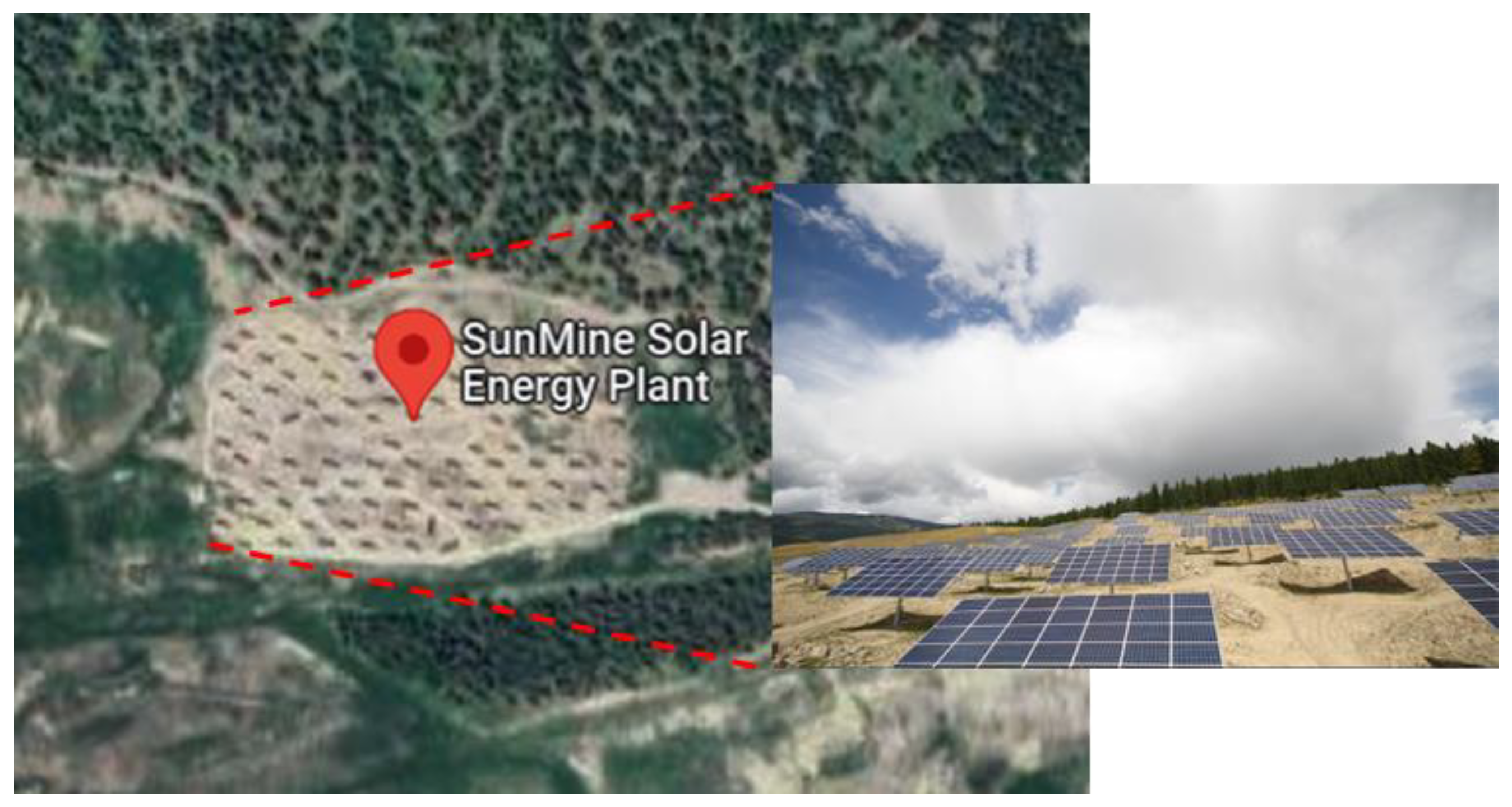
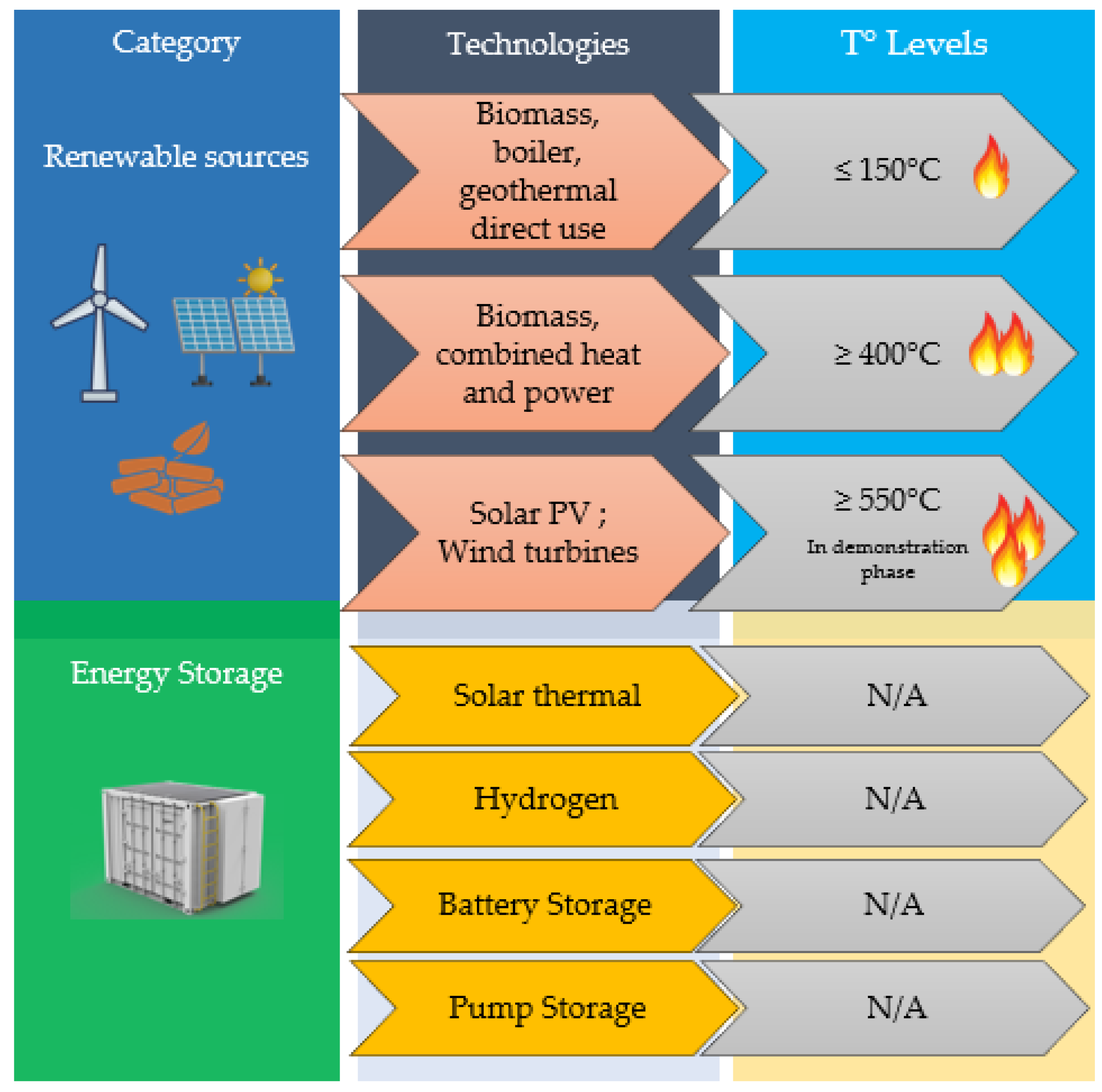
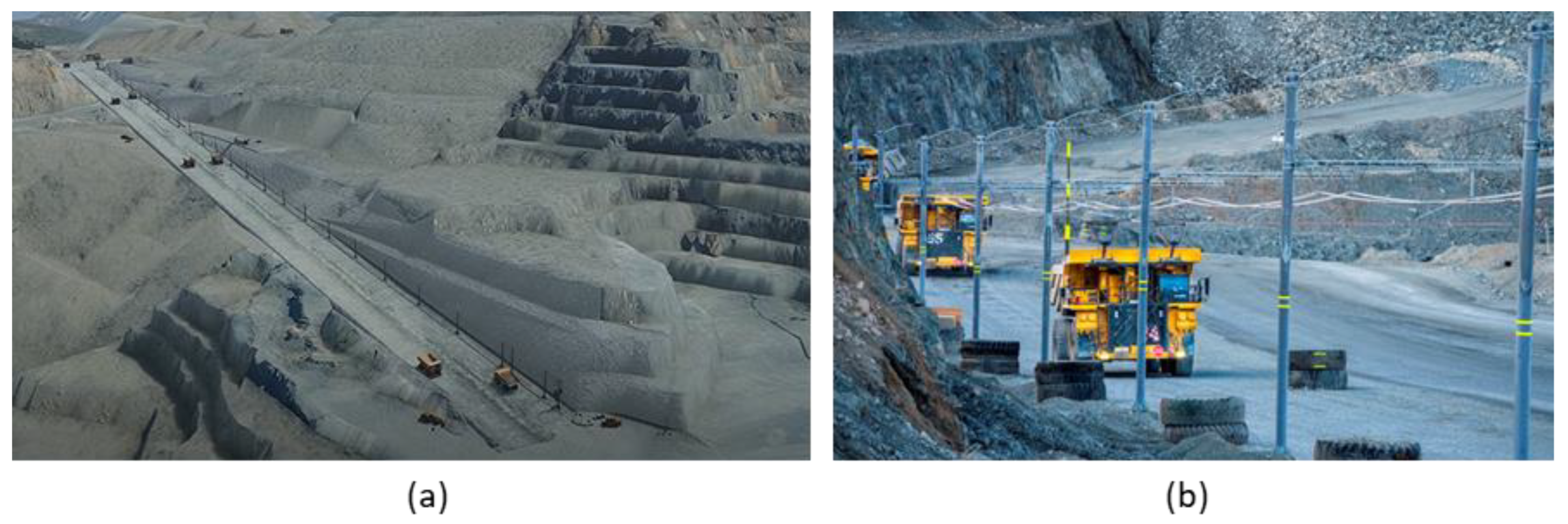
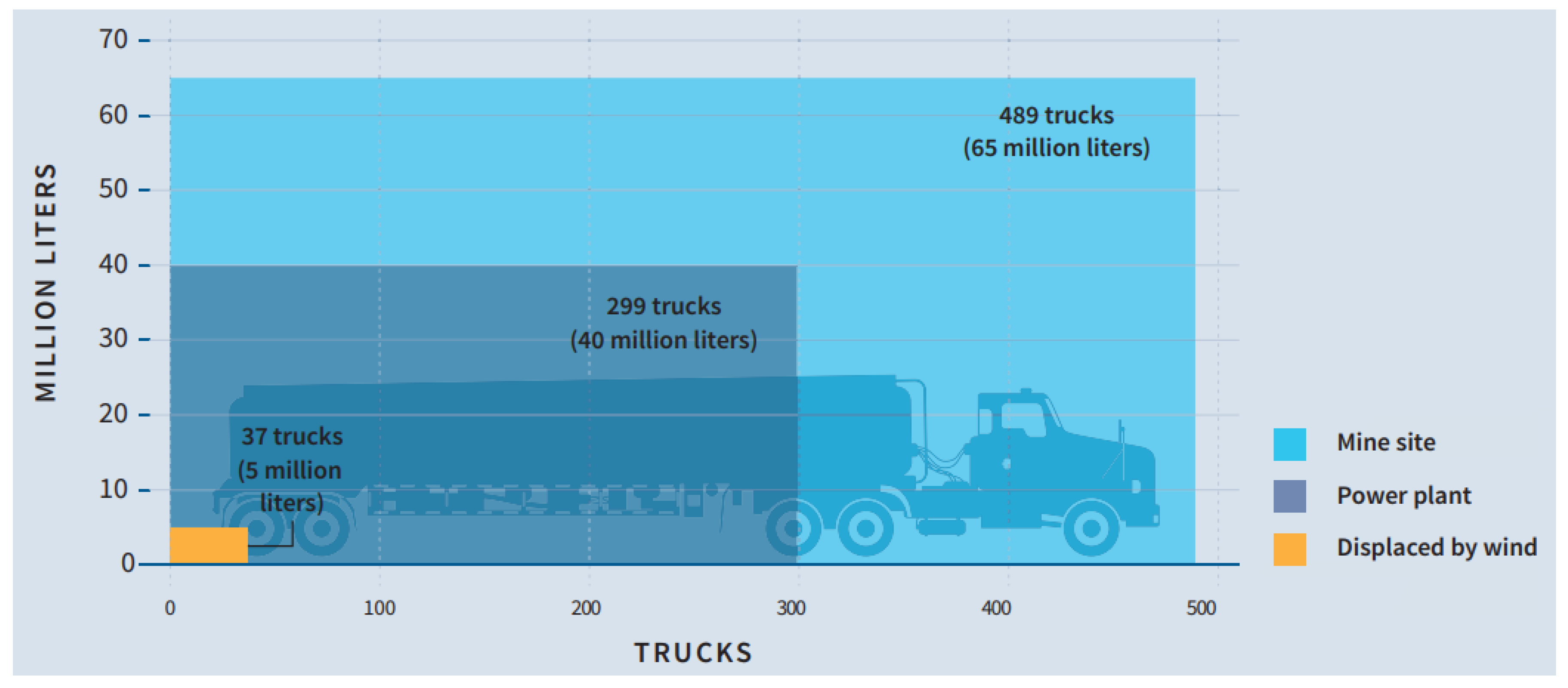
| Project | Operator/Owner | Location | Type of RE |
|---|---|---|---|
| Port Hope Simpson | Search Minerals Inc. | New Labrador | Biofuels and/or hydroelectric |
| Raglan Mine | Glencore | Quebec | Wind energy, solar energy, and storage system |
| Zeus (Kipawa) | Matamec Explorations Inc. | Quebec | Hydroelectric (downstream) |
| Ashram | Commerce Resources Corp. | Quebec | Possibility of wind energy |
| Diavik Diamond | Rio Tinto | Northwest Territories | Wind energy |
| Hope Bay | Agnico Eagle | Nunavut | Wind energy, with a storage system |
| Goose Gold mine | B2Gold | Nunavut | Wind energy, solar energy, and storage system |
| Éléonore | Goldcorp | Quebec | Geothermal energy |
| Cynthia | Snowline Gold Corp. | Yukon | Solar energy |
| Mining Process | Equipment and Activities | Fuel Type |
|---|---|---|
| Exploring, extracting, and operating | Power supply | Diesel |
| Ventilation | Electricity | |
| Drilling | Diesel, compressed air, and electricity | |
| Pumping | Electricity | |
| Digging | Electricity and diesel | |
| Material handling | Various transport systems (trucks, bulldozers, bulk trucks, etc.) | Diesel, electricity |
| Continuous handling systems (conveyor, pumps, etc.) | Electricity | |
| Processing | Comminution | Electricity |
| Separation | Electricity and diesel | |
| Drying, firing, and smelting | Diesel |
| Project | Operator/Owner | Fleet Description |
|---|---|---|
| Borden Lake, Ontario | Goldcorp | Canada’s first fully electric underground mine (fully electric fleet) |
| Macassa Mine in Kirkland Lake, Ontario | Agnico Eagle | Twenty-two battery electric scoops with 6 × Z50 trucks (a 50 tonne-battery-powered haul truck) |
| Onaping Depth Nickel-Copper Project, Ontario | Glencore Canada | An entire fleet of Epiroc battery-electric mining equipment (scoop tram loader, Minetruck hauler, Boomer face drilling rig, Cabletec rock bolting rig, and drill rig) |
| Lamaque Gold Mine, Quebec | Eldorado Gold | Two Sandvik TH550B battery-electric trucks |
| NMG open-pit, Quebec | Nouveau Monde Graphite | One × 40-tonne Western Star 6900XD |
| Brucejack Mine, British Columbia | Newcrest Mining | 12 electric haul trucks |
| Mcllvenna Bay Project, Saskatchewan | Foran Mining Corporation | Fleet of 20 BEVs, including trucks, loaders, and drill |
| BHP Jansen Potash Project, Saskatchewan | BHP Group | Ten underground battery electric loaders and one electric tethered loader |
| IPCC Type | Fixed | Semi-Mobile | Fully-Mobile |
|---|---|---|---|
| Crusher type | Jaw or gyratory | Twin roll or sizer | Twin roll or sizer |
| Relocation times | Never or rarely | Every 6-18 months | As needed |
| Feed systems | Shovel-trucks | Shovel-trucks and dozers | Shovel |
| Application | Deep hard rock mine ore | Not common in deep rock mine ore or waste | Not common in deep rock mine ore or waste |
| Product | Primary Energy Sources | Land Use Intensity m2/MWh |
|---|---|---|
| Electricity | Nuclear | 0.1 |
| Wind | 1.0 | |
| Geothermal | 2.5 | |
| Solar PV | 10 | |
| Solar-concentrated solar power | 15 | |
| Biomass (crops) | 500 | |
| Liquified Fuel | Fossil fuel | 0.4 |
| Biofuels | Corn (maize) | 230 |
| Soybean | 400 | |
| Cellulose, short rotation coppice | 500 |
| Lifespan: 3–7 Years | Lifespan: >10 Years | |
|---|---|---|
| Diesel generators | ✓ | ✓ |
| Gas turbines | ✓ | ✓ |
| Solar PV | Unlikely | ✓ |
| Wind turbines | Unlikely | ✓ |
| Concentrated solar power | Unlikely | ✓ |
| Types | Decarbonization Solutions | Main Challenges |
|---|---|---|
| Renewable energies | Biofuels |
|
| Solar PV |
| |
| Wind turbines |
| |
| Electrification | TA |
|
| IPCC |
| |
| BEV |
|
Disclaimer/Publisher’s Note: The statements, opinions and data contained in all publications are solely those of the individual author(s) and contributor(s) and not of MDPI and/or the editor(s). MDPI and/or the editor(s) disclaim responsibility for any injury to people or property resulting from any ideas, methods, instructions or products referred to in the content. |
© 2023 by the authors. Licensee MDPI, Basel, Switzerland. This article is an open access article distributed under the terms and conditions of the Creative Commons Attribution (CC BY) license (https://creativecommons.org/licenses/by/4.0/).
Share and Cite
Issa, M.; Ilinca, A.; Rousse, D.R.; Boulon, L.; Groleau, P. Renewable Energy and Decarbonization in the Canadian Mining Industry: Opportunities and Challenges. Energies 2023, 16, 6967. https://doi.org/10.3390/en16196967
Issa M, Ilinca A, Rousse DR, Boulon L, Groleau P. Renewable Energy and Decarbonization in the Canadian Mining Industry: Opportunities and Challenges. Energies. 2023; 16(19):6967. https://doi.org/10.3390/en16196967
Chicago/Turabian StyleIssa, Mohamad, Adrian Ilinca, Daniel R. Rousse, Loïc Boulon, and Philippe Groleau. 2023. "Renewable Energy and Decarbonization in the Canadian Mining Industry: Opportunities and Challenges" Energies 16, no. 19: 6967. https://doi.org/10.3390/en16196967
APA StyleIssa, M., Ilinca, A., Rousse, D. R., Boulon, L., & Groleau, P. (2023). Renewable Energy and Decarbonization in the Canadian Mining Industry: Opportunities and Challenges. Energies, 16(19), 6967. https://doi.org/10.3390/en16196967








